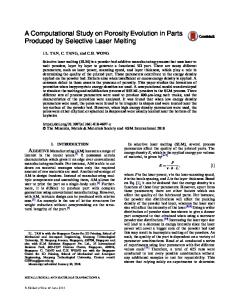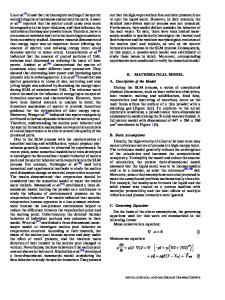Study and modeling of melt pool evolution in selective laser melting process of SS316L
- PDF / 910,457 Bytes
- 6 Pages / 612 x 792 pts (letter) Page_size
- 65 Downloads / 284 Views
Research Letter
Study and modeling of melt pool evolution in selective laser melting process of SS316L J. L. Tan, Singapore Centre for 3D Printing, School of Mechanical and Aerospace Engineering, Nanyang Technological University, 50 Nanyang Avenue, Singapore 639798, Singapore; SLM Solutions Singapore Pte. Ltd., 25 International Business Park, #02-15/17 German Centre, Singapore 609916, Singapore C. Tang, and C. H. Wong, Singapore Centre for 3D Printing, School of Mechanical and Aerospace Engineering, Nanyang Technological University, 50 Nanyang Avenue, Singapore 639798, Singapore Address all correspondence to C. H. Wong at [email protected] (Received 27 May 2018; accepted 15 August 2018)
Abstract In this paper, the melting of stainless steel 316L using Computational Fluid Dynamics to observe the melt pool characteristics is studied. The simulation model allows the observation of the molten pool flow during the selective laser melting process due to Marangoni’s effect and recoil pressure. Furthermore, different parameters are tested to show their effects on the melt pool and track formation. Different laser powers, as well as scanning speeds, were used to study the effects they have on the melt pool characteristics. The results were used to determine the relationships between these factors and the melt pool characteristics.
Introduction Selective laser melting (SLM) manufactures a threedimensional (3D) object by adding layer upon layers.[1] In SLM, a layer of powder is deposited and the laser will scan at the areas marked in the sliced stereolithography file. Once the laser has completed the scanning, a fresh layer of powder will be deposited and the process will repeat until the part is completed. It has seen applications in various industries such as aerospace, automotive as well as medical.[2,3] Its freedom of design allows the incorporation of lattice structures to produce lightweight parts.[4,5] SLM is a complex process which involves numerous parameters such as laser power, scanning speed, hatch spacing, layer, and scanning strategy. These parameters contribute to the energy density applied on the powder bed, and will affect the quality of the part.[6–8] Gan and Wong observed that by varying the layer thickness, the porosities and the mechanical properties of the printed parts are affected.[9] However, it was found that parameters such as the scanning speed and laser power exhibit larger influence over the part’s properties.[10] Relying on experiments to conduct parametric studies can be costly and time-consuming. The use of numerical modeling can assist in determining the optimum sets of processing parameters. Khairallah et al. made use of a numerical model to study the Plateau–Rayleigh instability phenomena on the continuity of the melt track.[11] Kruth et al. explained the melt pool will tend to reduce its free surface energy. The melt pool can be treated as a half cylinder and when the total surface of the melt pool exceeds that of a sphere with the same volume, it will break to form spheres known as the bal
Data Loading...











